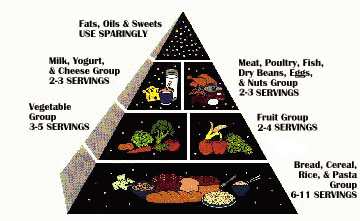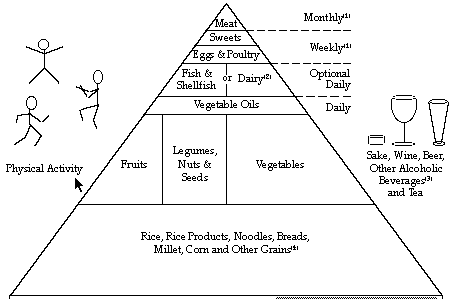|

Long, healthy life's in the food
pyramid
   
 
Supplements
The word supplement means in addition to something – to make up for a
deficiency. Vitamin and mineral supplements should be taken in addition to a
healthy diet. They make up for the deficiency we face due to the poor
nutrient density in our foods. Supplements also help out when our diet is
less than perfect.
The simplest way to help support your
nutrition is to take a general multi-vitamin and mineral supplement that
provides a broad range of nutrients at standard nutritional levels. However,
please keep the following points in mind:
- Some supplements contain very high
doses of certain nutrients. When you take nutrients in extremely high
doses, you are no longer in the world of nutritional supplementation and
have passed into the riskier world of megadose treatment.
- Calcium and magnesium minerals are
very bulky, and few multi-vitamin/mineral supplements provide the daily
requirement. These minerals generally must be taken in the form of
additional pills. Note: It isn't possible for your body to absorb a
day's worth of calcium in a single dose. At least two doses are
necessary.
The most common nutritional
deficiencies
| Calcium |
Helps with bone density,
muscle contraction and digestion |
| Chromium |
Helps with blood sugar control |
| Magnesium |
Helps protect against high
blood pressure, kidney stones and migraine headaches |
| Vitamin C |
Helps with detoxification,
immune system health and connective tissue |
| Vitamin
B-12 |
Helps protect
against anemia and fatigue. Helps with nerve health and energy |
| Vitamin D |
Involved in bone and skin
health and helps protect against diabetes and obesity |
| Vitamin E |
Helps improve
circulation |
| Zinc |
Helps protect against acne,
ADD/ADHD, the common cold and macular degeneration |
Very few of us are so deficient in these
nutrients as to show symptoms of outright malnutrition. However, subtle
deficiencies may increase the risk of a number of conditions. For example,
insufficient intake of calcium and Vitamin D may increase your chances of
developing osteoporosis, and inadequate folate and Vitamin B-6 may speed the
development of heart disease.
Take Control of Your Health
- Eat the appropriate amount of fruits/vegetables
daily:
- Children: 5 servings
- Women: 7 servings
- Men: 9 servings
- Focus on organic whenever possible
- Eat high quality protein daily (34 to 71
grams)
- Eat Omega-3 fats every day (flax,
walnuts & some fish)
- Take a balanced multiple vitamin/mineral
supplement
- Take EFA supplement like
Salmon Oil
- Take Vitamin
B-12 every morning
- Take Vitamin
C every morning and at bedtime
Food Pyramid
Want to eat
healthily? Following the food pyramid is good enough, says a biomedical
science professor, Willem van Gelder, who is also the global research
director for Numico, a Dutch specialised nutrition company.
 
|
| Expert tips: Don't think too much about all kinds of
ingredients in the food, but look more to the different types of
food as in the food pyramid. The general advice is to have a base of
starches, followed by vegetables and fruits, and not too much red
meat |
'There's really nothing much more to add to that. Different countries
will have slightly different pyramids, but overall the general advice is to
have a base of starches, followed by vegetables and fruits, and not too much
red meat,' he says. Prof van Gelder was in town this week to deliver a talk
at the Silver Industry Conference and Exhibition (Sicex) on 'Eating to a
Long and Healthy Life'.
People need to up their intake of fish for Omega 3 fatty acids, because
they generally tend to get more than enough Omega 6 from vegetable sources.
'That ratio should be shifted,' says Prof van Gelder.
And then general advice such as physical activity - 'Which everyone knows
but doesn't do enough of,' he adds - and not taking harmful foods like
saturated fats.
In the wake of the varieties of food and diet fads that come and go, Prof
van Gelder advocates a balanced diet, and says that good nutrition starts
the minute we're born. 'For a baby, healthy eating starts with mother's
milk,' he points out. The alternative, if a mother's milk is unavailable, is
infant formula from a credible company which backs its formula with clinical
trials, he says.
Numico's major discovery in the past few years, for instance, was in the
field of infant formula. It found out that breast milk contained a family of
specific carbohydrates which are non-digestible in the baby's intestines,
but which fed the 'good' bifido bacteria contained in the intestines.
'The bacteria was for the development of the baby's natural immune
system. The baby inherits this from its mother when it's born,' he notes.
The company found similar ingredients in bananas, for example, and
introduced Gos-Fos, or galacto and fructo oligosaccharides, in baby formula.
'And specifically, long-chain galacto oligosaccharides because these help
feed the bifido bacteria which helps fight against allergy, infection and
diarrhoea,' he says.
This type of research is part of the nutritional therapy work that Numico
does, in which it enlists the participation of top scientists in the various
fields.
Nutritional therapy isn't like supplementation, points out Prof van
Gelder, in the sense that it's about developing specialised compositions
that bring many ingredients together. 'We believe that nutritional
components brought together in harmony can deal with complex diseases,' he
says.
One such disease under research now is Alzheimer's, which can be delayed
by five years if detected and treated early. 'The brain cells consist of
water and lipids, and cells are regulated by nutrients,' he says.
Theories also being studied now include metabolic imprinting, which is
the concept that nutrients (or what you eat) might impact the expression of
genes in the very early phase of life. Based on that, Numico is now trying
to find out which ingredients in baby food, specifically, influence the
formation and distribution of fat cells in the body.
'Insights in obesity are changing now because not all people who are big
have unhealthy fat. It's a question of unhealthy visceral fat (around the
organs) and subcutaneous fat which was designed by nature as a storage
source,' he notes.
While research like this would probably take a long time, till then it's
best to follow the recommendations given by the health authorities. 'I'd
advise people not to think too much about all kinds of ingredients in the
food, but look more to the different types of food as in the food pyramid,'
he concludes.
- 2008 January 12 SINGAPORE
BUSINESS TIMES
Food
Pyramid bricks in wrong spots
Canadian
and U.S. food guidelines designed to encourage people to eat healthily
are flawed, a new study from researchers at Harvard School of Public
Health suggests.
If
the U.S. Food Pyramid,
which closely resembles Health Canada's Food Guide chart,
was revised it would significantly reduce the number of people dying from
heart attacks, strokes and other chronic diseases, the scientists say.
"The
Food Pyramid is tremendously flawed," said Walter Willett, chairman of
the Department of Nutrition at
the Harvard School of Public Health.
Prof.
Willett observed of the old pyramid: "It says all fats are bad; all
complex carbohydrates are good; all protein sources offer the same nutrition;
and dairy should be eaten in high amounts. None of this is accurate,"
said Walter Willett, chairman of the Department of Nutrition at
the Harvard School of Public
Health.
Prof.
Willett has designed a new health pyramid after assessing the diets of
more than 100,000 men and women in the United States.
Men
and women whose diet most closely followed the new guidelines lowered
their risk of cardiovascular
disease by 39% and 28% respectively, he said.
The
researchers found that men whose diet followed the guidelines lowered
their overall risk of major
chronic disease by 20% and women lowered their
overall risk by 11%.
Using
the old U.S. pyramid, the researchers found the overall risk reduction
was 11% for men and 3% for women.
The
researchers did not study Canada's Food Guide, which is undergoing a
review.
"We
are undertaking a review because of new scientific data. The Food Guide
has existed since 1990 and represented the best science at the time,"
said Margot Geduld, a spokeswoman for Health Canada. "The Food Guide is
still very useful," she
said.
Prof.
Willett's new guidelines differ from the old pyramid and the Canadian
chart in the way they treat grains, meats and oils.
His
pyramid also says alcohol in moderation can be healthy.
"The
current [U.S.] guidelines as displayed in the government food guide
pyramid emphasizes large
amounts of carbohydrates, doesn't make a distinction
between types of fat or protein and lumps red meat, chicken, nuts
and legumes together," Prof. Willett said.
Like
the U.S. pyramid, the Canadian Food Guide lists grain products such as
bread, pasta and rice in one
category although the Canadian guide adds, "Choose
whole grain and enriched products more often."
Prof.
Willett's pyramid differentiates between whole grain foods (which he
recommends eating at most
meals) and white rice, white bread, potatoes, pasta
and sweets, which he says should be eaten sparingly.
The
Willett pyramid also differentiates between fish and poultry and red
meat.
"In
our study we gave people credits for consuming fish and poultry. People
who choose chicken over red
meat got higher credits," Marjorie McCullough, a nutritional
epidemiologist who worked with Prof. Willett on the research, said.
The
U.S. pyramid and Canada's food chart put fish, poultry and meat in the
same category.
One
of the most common mistakes people make when trying to eat healthily is
getting rid of fat in their
diet, Prof. Willett said.
"Not
all fats are bad and, in fact, some should be required in any diet.
Mono-unsaturated and
polyunsaturated fats found in foods such as nuts, avocados,
fish, olives and most oils help lower 'bad' cholesterol levels without
affecting 'good' cholesterol levels," he said in an interview with a Harvard
magazine.
The
U.S. pyramid puts fats and oils at the top and says use sparingly. The
Canadian food chart says,
"Some of these foods are higher in fat or calories so use these foods
in moderation."
"The
Willett's pyramid considers sources of fat as good," said Ms.
McCullough.
Thomas Wolever, a professor at the nutritional sciences department at the
University of Toronto, said such guidelines are an attempt to give a basic message
about a complex subject.
"[Prof.
Willett] is trying to give a simple message. People do want a black
and white answer," said
Prof. Wolever, who added he agreed with some of Prof.
Willett's findings but not with others.
- 2002
November 22 National
Post

You
are what you eat, so eat well. The following contends that every
whole food has a pattern that resembles a body organ or physiological
function and that this pattern acts as a signal or sign as to the benefit
the food provides the eater.
-
A
sliced Carrot looks like the human eye. The pupil, iris and radiating
lines look just like the human eye...and YES science now shows that
carrots greatly enhance blood flow to and function of the eyes.
-
A
Tomato has four chambers and is red. The heart is red and has four
chambers. All of the research shows tomatoes are indeed pure heart and
blood food.
-
Grapes
hang in a cluster that has the shape of the heart. Each grape looks like
a blood cell and all of the research today shows that grapes are also
profound heart and blood vitalizing food.
-
A
Walnut looks like a little brain, a left and right hemisphere, upper
cerebrums and lower cerebellums. Even the wrinkles or folds are on the
nut just like the neo-cortex. We now know that walnuts help develop over
3 dozen neuron-transmitters for brain function.
-
Kidney
Beans actually heal and help maintain kidney function and yes, they look
exactly like the human kidneys.
-
Celery,
Bok Choy, Rhubarb and more look just like bones. These foods
specifically target bone strength. Bones are 23% sodium and these foods
are 23% sodium. If you don't have enough sodium in your diet the body
pulls it from the bones, making them weak. These foods replenish the
skeletal needs of the body.
-
Eggplant,
Avocadoes and Pears target the health and function of the womb and
cervix of the female - they look just like these organs. Today's
research shows that when a woman eats 1 avocado a week, it balances
hormones, sheds unwanted birth weight and prevents cervical cancers. And
how profound is this? .... It takes exactly 9 months to grow an avocado
from blossom to ripened fruit. There are over 14,000 photolytic chemical
constituents of nutrition in each one of these foods (modern science has
only studied and named about 141 of them).
-
Figs
are full of seeds and hang in twos when they grow. Figs increase the
motility of male sperm and increase the numbers of Sperm as well to
overcome male sterility.
-
Sweet
Potatoes look like the pancreas and actually balance the glycemic index
of diabetics.
-
Olives
assist the health and function of the ovaries.
-
Grapefruits,
Oranges, and O there Citrus fruits look just like the mammary glands of
the female and actually assist the health of the breasts and the
movement of lymph in and out of the breasts.
-
Onions
look like body cells. Today's research shows that onions help clear
waste materials from all of the body cells They even produce tears which
wash the epithelial layers of the eyes
Hmmm...not
sure if we believe all of this but certainly something to consider if you
like these foods anyways.

|